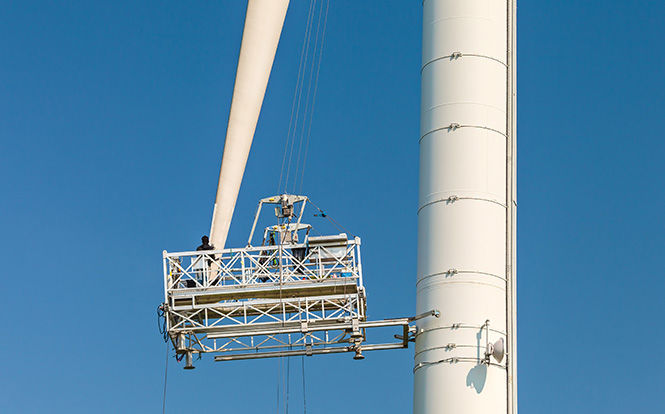Accurate Forecasting During Severe Weather Season: helping techs and turbines work better
 During severe weather season, the risks of lightning and high winds are top of mind both in terms of employee safety and potential equipment damage. Lightning is clearly a potential issue for turbine technicians, but it is also one of the biggest threats to wind turbines performance. And wind, even though it's at the heart of the industry, can be particularly dangerous to technicians working on turbines as well as the equipment itself.
During severe weather season, the risks of lightning and high winds are top of mind both in terms of employee safety and potential equipment damage. Lightning is clearly a potential issue for turbine technicians, but it is also one of the biggest threats to wind turbines performance. And wind, even though it's at the heart of the industry, can be particularly dangerous to technicians working on turbines as well as the equipment itself.
With so many wind farms operating in the path of volatile and unpredictable weather patterns, it can make operations and maintenance challenging to manage. Using the most accurate weather forecasting and data available can help wind farm operators better protect their assets and employees from weather related risks.
Lightning Risks
Cloud-to-ground lightning bolts are a common phenomenon; there are about 100 strikes per second throughout the world. That's seven to eight million strikes per day that can put wind farms at risk. There's the obvious risk to technicians working during times of potential lightning strikes, but the direct and near-strike damage to wind turbines can result in downtime, which can impact ongoing and reliable turbine performance.
There are many options for monitoring lightning, but relying on someone to listen for thunder or watch local radar to ensure worker safety doesn't cut it when compared to the significant advances made in weather technology.There are weather services available that can detect and forecast lightning strikes, as well as provide high-quality, timely mobile alerts for technicians. When evaluating a weather source, here are some potential questions to ask to make sure the needed information is available: Does the system offer alerts based on a GPS location? Is there real-time, location-specific information on strikes? Do the alerts offer suggested actions?
Accurate weather information can also help determine the damage risks to turbines from both direct and near lightning strikes. By using accurate lightning strike information, operators can efficiently protect and repair specific turbines needing attention. Global lightning detection networks offer operational insight that can help establish an accurate, efficient approach to protecting turbines during severe weather. Knowing distance, amperage, polarity, time, and location of lightning strikes can help drive maintenance decisions, such as whether a turbine should be inspected first or just restarted after a fault. That information can also help determine if lightning damaged a blade or other equipment. If wind blade damage goes unnoticed, it could lead to further malfunctions, which commonly contributes to lower power generation.
 Extreme Wind Risks
Extreme Wind Risks
In general, more is better - but not with wind. High winds can pose a safety factor for technicians working on turbines; when technicians can't safely work, the extreme winds also interrupt or delay turbine maintenance, threatening both the operation of equipment and safety of the maintenance crew.
To operate at peak efficiency, wind farms will benefit from using hub height wind forecasts to identify when each turbine will surpass normal operational thresholds. Understanding when turbines are most at risk from high winds allows operators and technicians to strategically schedule both internal and outside maintenance.
Winds at hub height can significantly differ from surface level winds. It can be a mistake to use forecasting tools that measure wind speed at ground level, leaving it to the wind farm operator to estimate how that translates to hub height. Additionally, forecasts should be gathered at the wind farm itself, where winds can be significantly higher than at the nearest weather station. Using hub height and gust forecasts can help turbines perform at optimal efficiency.
And, by choosing a weather forecasting tool that can predict wind speeds and gusts as early as a week in advance, operators can go ahead and hire expensive outside resources such as a crane, lift, or rope crews, without worrying if weather will delay their efforts.
With an understanding of available weather information that can accurately predict approaching storms, track lightning strikes in relation to turbines, forecast hub height wind speeds, and other specific information, operators can harness the information to safely and efficiently plan maintenance schedules around inclement weather, and help keep maintenance crews safe and the operation working without interruptions.
Ivan Gearhart is an Energy Regional Sales Manager with DTN. Ivan has been active in the wind power industry since 2006, consulting with wind plant operators and developers on both safety and wind plant optimization solutions. He's a graduate of Ohio University, Athens, Ohio, where he earned a Bachelor of Science in Communications. Ivan lives with his family in Lincoln, Nebraska.
DTN | dtn.com
Author: Ivan Gearhart
Volume: 2019 May/June









